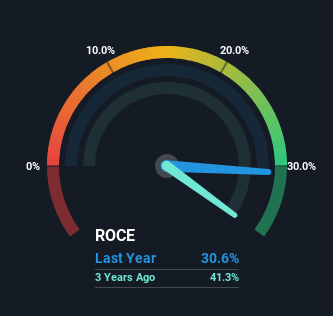- South Korea
- /
- Medical Equipment
- /
- KOSDAQ:A287410
The Returns On Capital At Jeisys Medical (KOSDAQ:287410) Don't Inspire Confidence

What trends should we look for it we want to identify stocks that can multiply in value over the long term? One common approach is to try and find a company with returns on capital employed (ROCE) that are increasing, in conjunction with a growing amount of capital employed. Basically this means that a company has profitable initiatives that it can continue to reinvest in, which is a trait of a compounding machine. So when we looked at Jeisys Medical (KOSDAQ:287410), they do have a high ROCE, but we weren't exactly elated from how returns are trending.
Understanding Return On Capital Employed (ROCE)
If you haven't worked with ROCE before, it measures the 'return' (pre-tax profit) a company generates from capital employed in its business. The formula for this calculation on Jeisys Medical is:
Return on Capital Employed = Earnings Before Interest and Tax (EBIT) ÷ (Total Assets - Current Liabilities)
0.31 = ₩36b ÷ (₩142b - ₩24b) (Based on the trailing twelve months to December 2023).
So, Jeisys Medical has an ROCE of 31%. In absolute terms that's a great return and it's even better than the Medical Equipment industry average of 11%.
View our latest analysis for Jeisys Medical

In the above chart we have measured Jeisys Medical's prior ROCE against its prior performance, but the future is arguably more important. If you'd like, you can check out the forecasts from the analysts covering Jeisys Medical for free.
How Are Returns Trending?
In terms of Jeisys Medical's historical ROCE movements, the trend isn't fantastic. While it's comforting that the ROCE is high, three years ago it was 41%. However, given capital employed and revenue have both increased it appears that the business is currently pursuing growth, at the consequence of short term returns. If these investments prove successful, this can bode very well for long term stock performance.
On a related note, Jeisys Medical has decreased its current liabilities to 17% of total assets. That could partly explain why the ROCE has dropped. Effectively this means their suppliers or short-term creditors are funding less of the business, which reduces some elements of risk. Since the business is basically funding more of its operations with it's own money, you could argue this has made the business less efficient at generating ROCE.
The Bottom Line On Jeisys Medical's ROCE
In summary, despite lower returns in the short term, we're encouraged to see that Jeisys Medical is reinvesting for growth and has higher sales as a result. And the stock has done incredibly well with a 109% return over the last three years, so long term investors are no doubt ecstatic with that result. So while the underlying trends could already be accounted for by investors, we still think this stock is worth looking into further.
On a separate note, we've found 1 warning sign for Jeisys Medical you'll probably want to know about.
High returns are a key ingredient to strong performance, so check out our free list ofstocks earning high returns on equity with solid balance sheets.
New: Manage All Your Stock Portfolios in One Place
We've created the ultimate portfolio companion for stock investors, and it's free.
• Connect an unlimited number of Portfolios and see your total in one currency
• Be alerted to new Warning Signs or Risks via email or mobile
• Track the Fair Value of your stocks
Have feedback on this article? Concerned about the content? Get in touch with us directly. Alternatively, email editorial-team (at) simplywallst.com.
This article by Simply Wall St is general in nature. We provide commentary based on historical data and analyst forecasts only using an unbiased methodology and our articles are not intended to be financial advice. It does not constitute a recommendation to buy or sell any stock, and does not take account of your objectives, or your financial situation. We aim to bring you long-term focused analysis driven by fundamental data. Note that our analysis may not factor in the latest price-sensitive company announcements or qualitative material. Simply Wall St has no position in any stocks mentioned.
About KOSDAQ:A287410
Jeisys Medical
Designs, develops, and manufactures medical device for plastic surgeons, dermatologist, physicians, and healthcare professionals in South Korea and internationally.
High growth potential with excellent balance sheet.
Market Insights
Community Narratives




